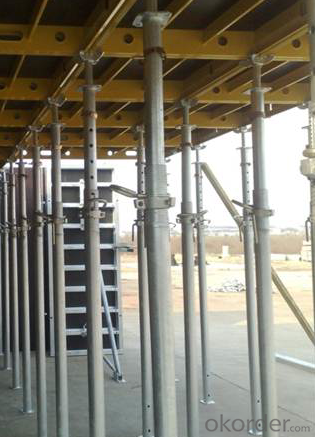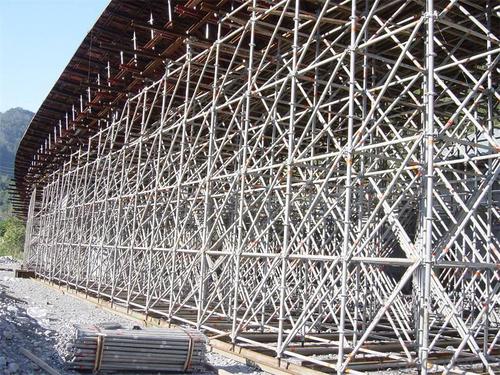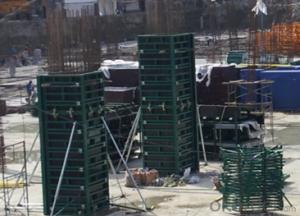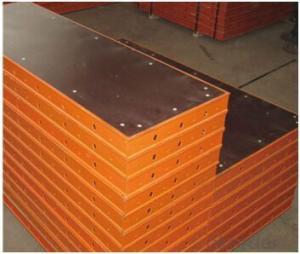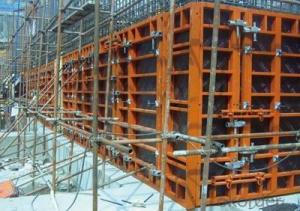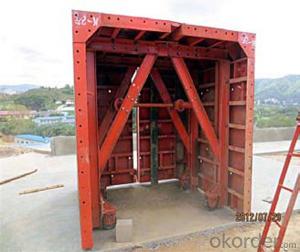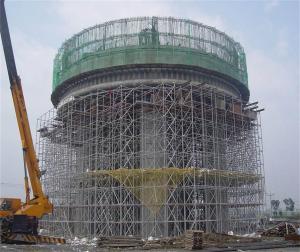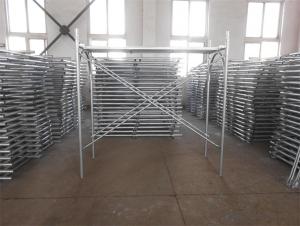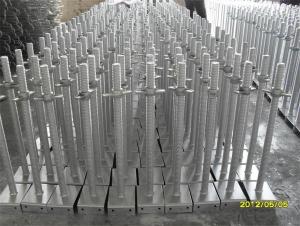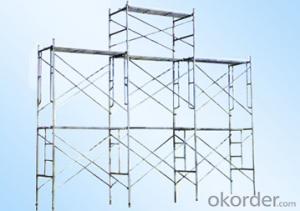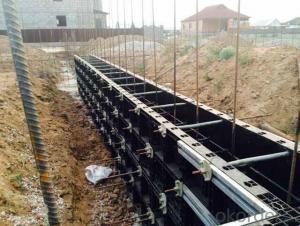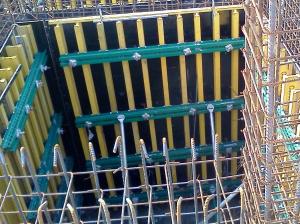Ring-Lock Scaffolding ,Tower Scaffolding with Hot or Cold Galvanized Surface
- Loading Port:
- Shanghai
- Payment Terms:
- TT OR LC
- Min Order Qty:
- 1000 m²
- Supply Capability:
- 100000 m²/month
OKorder Service Pledge
OKorder Financial Service
You Might Also Like
1.Structure of Ring lock Description
Ringlock Scaffolding system is the most popular used Scaffolding system in the world.It will greatly reduce the cost because of the following advantages
Packaging & Delivery
Packaging Details:
Pallet or bag or upon client's request
Delivery Detail:
35days
2.Main Features of Ringlock
It will greatly reduce the cost because of the following advantages
1)Using less pipes
2)Easy to install
3)It can be used again and again for nearly 20years
3.Ring lock product pictures:
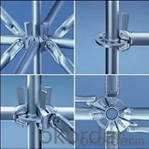
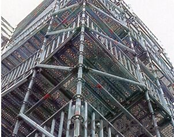
4.Ringlock Product Description
Type: ringlock scaffolding diagonal Brace
specification : Ø48.3×3.20
material:: steel Q235
Finished: Hot DIP galvanized, painted
Diagonal length(m) :Weight(kg)
0.9m * 1.25m 6.28
1.25m * 2.7m 11.45
5.FAQ
We have organized several common questions for our clients,may help you sincerely:
1)How about your company?
CNBM International Corporation, China National Building Materials (Group) Corporation, is one of the largest companies in China building material equipment industry, Our formwork and scaffolding are largely used in both domestic and all over world;
2)How many Scaffolding your company have?
Here comes our 5 types of Scaffolding systems:
- Cup lock Scaffolding(C-Lock Scaffolding)
- Ring lock Scaffolding
-Kwistage Scaffolding
-H-frame Scaffolding
-ID15 Scaffolding Tower, this type Scaffolding is the most widely used in construction, such like bridge.
3)How long can we receive the product after purchase?
Lead time is about 30days after getting the signed PI and deposit.
- Q: What are the key considerations for selecting the appropriate steel frame formwork system for tall structures?
- When choosing the suitable steel frame formwork system for tall structures, there are several important factors that need to be taken into consideration: 1. Load-bearing capacity: The formwork system must be capable of withstanding the weight of the concrete and other materials used in the construction of tall structures. It should possess a high load-bearing capacity to guarantee the safety and stability of the structure. 2. Flexibility and adjustability: Tall structures often have intricate shapes and varying floor plans. The formwork system should be adaptable and adjustable to accommodate these design variations. It should be able to conform to different heights, angles, and curves to ensure precise and accurate construction. 3. Speed and efficiency: The construction of tall structures requires a fast and efficient formwork system to meet project deadlines. The chosen system should be easy to install, dismantle, and relocate to different levels. It should also facilitate quick pouring and curing of concrete to expedite the construction process. 4. Safety: Safety is of paramount importance in any construction project, particularly in tall structures. The formwork system should include safety features such as guardrails, handrails, and non-slip surfaces to safeguard workers from falls and accidents. It should also provide adequate access and exit points to ensure the safe movement of workers within the structure. 5. Durability and reusability: Tall structures often necessitate multiple concrete pours, so the formwork system should be durable enough to withstand repeated use without compromising its structural integrity. Additionally, it should be designed for easy dismantling, cleaning, and reassembly to minimize costs and waste. 6. Cost-effectiveness: Choosing a cost-effective formwork system is crucial for tall structures, as the project budget can be significantly impacted by the selection of formwork. The system should offer a good balance between quality, performance, and cost. It is important to consider not only the initial investment but also the long-term maintenance and reusability costs. By taking these key factors into account, project managers and engineers can select the most suitable steel frame formwork system for tall structures, ensuring the efficient, safe, and successful completion of the construction project.
- Q: Can steel frame formwork be used in earthquake-prone areas?
- Yes, steel frame formwork can be used in earthquake-prone areas. Steel is known for its durability and strength, making it suitable for construction in areas prone to seismic activity. Steel frame formwork provides a rigid structure that can withstand the forces generated during an earthquake, ensuring the safety and stability of the building. Additionally, steel formwork can be easily assembled and disassembled, allowing for quick and efficient construction, which is especially beneficial in earthquake-prone areas where time is of the essence. However, it is important to follow the relevant building codes and regulations specific to the area to ensure the proper design and installation of the steel frame formwork system.
- Q: ANSYS steel frame structure modeling, commonly used in size, density, Poisson's ratio is much better? Help。
- Steel structure with a long time carbon structural steel, the size of the size of the steel you actually use
- Q: What safety measures need to be taken when using steel frame formwork?
- When using steel frame formwork, several safety measures should be taken to ensure the well-being of workers and the overall success of the construction project. These safety measures include: 1. Adequate training: Workers should receive proper training on how to handle and assemble steel frame formwork. This includes understanding the correct procedures for setting up, dismantling, and moving the formwork. 2. Inspection and maintenance: Regular inspection of the steel frame formwork is essential to identify any potential hazards or defects. Any damaged or faulty parts should be repaired or replaced immediately to prevent accidents. 3. Secure anchorage: It is crucial to ensure that the steel frame formwork is securely anchored to the structure it is supporting. This will prevent any unexpected movements or collapse, reducing the risk of injuries. 4. Fall protection: Workers should be provided with appropriate fall protection measures when working at heights on the steel frame formwork. This may include the use of safety harnesses, guardrails, or safety nets. 5. Proper lifting techniques: When moving or handling steel frame formwork, workers should utilize proper lifting techniques to avoid strains or injuries. This may involve using mechanical lifting equipment, such as cranes or forklifts, to minimize the physical strain on workers. 6. Clear communication: Effective communication between workers is essential to ensure everyone is aware of their roles and responsibilities when working with steel frame formwork. Clear instructions and signage should be provided to prevent misunderstandings or confusion. 7. Adequate lighting and ventilation: Proper lighting and ventilation should be provided in the area where steel frame formwork is being used. This will help improve visibility and reduce the risk of accidents caused by poor lighting or inadequate air circulation. 8. Personal protective equipment (PPE): Workers should be provided with the necessary personal protective equipment, such as hard hats, safety goggles, gloves, and steel toe boots. This will protect them from potential hazards, such as falling objects or sharp edges. By implementing these safety measures, construction companies can minimize the risks associated with using steel frame formwork, creating a safer working environment for their employees and ensuring a successful construction project.
- Q: How does steel frame formwork ensure the stability of the concrete structure during pouring and curing?
- Steel frame formwork ensures the stability of the concrete structure during pouring and curing by providing a rigid and strong framework that holds the concrete in place. The steel frame acts as a support system, preventing any deformation or collapse of the structure while the concrete is being poured and during the curing process. This stability is crucial in ensuring that the concrete sets and hardens properly, resulting in a durable and structurally sound final product.
- Q: How does steel frame formwork accommodate for different concrete pumping methods?
- Steel frame formwork proves to be a versatile and adaptable system capable of effectively accommodating various concrete pumping methods. Its design ensures robustness and stability, facilitating the efficient transfer of forces during the concrete pouring process. A significant advantage of steel frame formwork lies in its ability to withstand the high pressures generated by different concrete pumping methods. Truck-mounted boom pumps, stationary pumps, and line pumps all exert forces during the pumping process, which the steel frame formwork can handle without compromising its structural integrity. Moreover, customization and adjustment options are readily available with steel frame formwork to cater to different concrete pumping methods. The formwork panels can be designed with openings like holes or slots to accommodate pipes and hoses used in the pumping process. This feature ensures smooth and efficient pumping operations, preventing any blockages or hindrances. Additionally, the steel frame formwork system is easily disassembled and reassembled, making it suitable for diverse project requirements and changing pumping methods. This flexibility allows for effortless modifications and adjustments to the formwork system, ensuring it can adapt to any alterations in the concrete pumping method during the construction process. Overall, steel frame formwork proves to be a dependable and adaptable solution for accommodating various concrete pumping methods. Its robust nature, stability, and customization options make it the preferred choice in construction projects where concrete pumping is necessary.
- Q: How does steel frame formwork compare to fiberglass formwork?
- Steel frame formwork and fiberglass formwork are both popular choices for construction projects, but they have distinct differences in terms of material composition, durability, and cost. Firstly, steel frame formwork is made of steel frames and plywood panels. This combination provides high strength and stability, making it suitable for heavy-duty applications. The steel frames can withstand heavy loads and offer excellent support for concrete pouring. Additionally, the plywood panels have high reusability, allowing for multiple uses in different projects. On the other hand, fiberglass formwork is made of reinforced fiberglass panels. This material is lightweight, yet still durable, offering advantages in terms of easier handling and transportation. The fiberglass panels are also resistant to various environmental factors such as water, chemicals, and UV radiation. This makes fiberglass formwork ideal for projects with specific requirements, such as those in coastal areas or in corrosive environments. In terms of durability, steel frame formwork is generally considered more resistant to wear and tear. Steel frames have a longer lifespan and can withstand rough handling and extreme weather conditions. They are also less prone to deformation and can be easily repaired or modified if needed. Fiberglass formwork, while durable, may be more susceptible to damage if mishandled or exposed to excessive force. However, proper care and maintenance can extend the lifespan of both types of formwork. Cost is another factor to consider when comparing steel frame formwork to fiberglass formwork. Steel frame formwork tends to be more expensive initially, as it requires the purchase of steel frames and plywood panels. However, due to its high reusability, the overall cost per project may be lower in the long run. Fiberglass formwork, while cheaper upfront, may need to be replaced more frequently, leading to higher overall costs over time. In conclusion, steel frame formwork and fiberglass formwork have their own advantages and disadvantages. Steel frame formwork offers high strength, stability, and durability, making it suitable for heavy-duty applications. Fiberglass formwork, on the other hand, is lightweight, resistant to environmental factors, and more cost-effective initially. Ultimately, the choice between the two will depend on the specific project requirements, budget constraints, and expected lifespan of the formwork.
- Q: What is the cost of steel frame formwork compared to other types of formwork?
- Various factors, such as project size, complexity, location, and specific requirements, can affect the cost of steel frame formwork. Comparatively, steel frame formwork tends to be more expensive than other materials like wood or aluminum. The higher cost of steel frame formwork primarily stems from the durability and strength of steel. Steel is renowned for its ability to withstand high loads and pressures, making it ideal for heavy-duty construction projects. Its long lifespan and resistance to wear and tear contribute to its higher price. Additionally, steel frame formwork offers several advantages over alternative forms, including better dimensional accuracy, increased stability, and enhanced reusability. These benefits, combined with steel's superior strength, make it a popular choice for large-scale construction projects that require precision and durability. While the initial investment in steel frame formwork may be higher, it proves cost-effective in the long run due to its extended lifespan and reusability. By eliminating the need for frequent replacements or repairs, steel frame formwork reduces overall project costs and improves efficiency. It is crucial to consider more than just the cost of formwork when selecting the most suitable option for a construction project. Factors like project requirements, timeline, and complexity should also be evaluated to make an informed decision. Consulting construction experts and assessing specific project needs can help determine the most cost-effective formwork solution.
- Q: How does steel frame formwork contribute to better formwork stability in high wind conditions?
- Steel frame formwork contributes to better formwork stability in high wind conditions due to its inherent strength and rigidity. The steel frame provides a sturdy support system that can withstand strong winds, preventing the formwork from being easily displaced or damaged. This stability ensures that the formwork remains in place during construction, allowing for accurate and precise concrete pouring. Additionally, the steel frame formwork can be securely anchored to the ground or to the building structure, further enhancing its resistance to wind forces. Overall, the use of steel frame formwork greatly reduces the risk of formwork failure or collapse in high wind conditions, ensuring the safety and efficiency of the construction process.
Send your message to us
Ring-Lock Scaffolding ,Tower Scaffolding with Hot or Cold Galvanized Surface
- Loading Port:
- Shanghai
- Payment Terms:
- TT OR LC
- Min Order Qty:
- 1000 m²
- Supply Capability:
- 100000 m²/month
OKorder Service Pledge
OKorder Financial Service
Similar products
Hot products
Hot Searches


